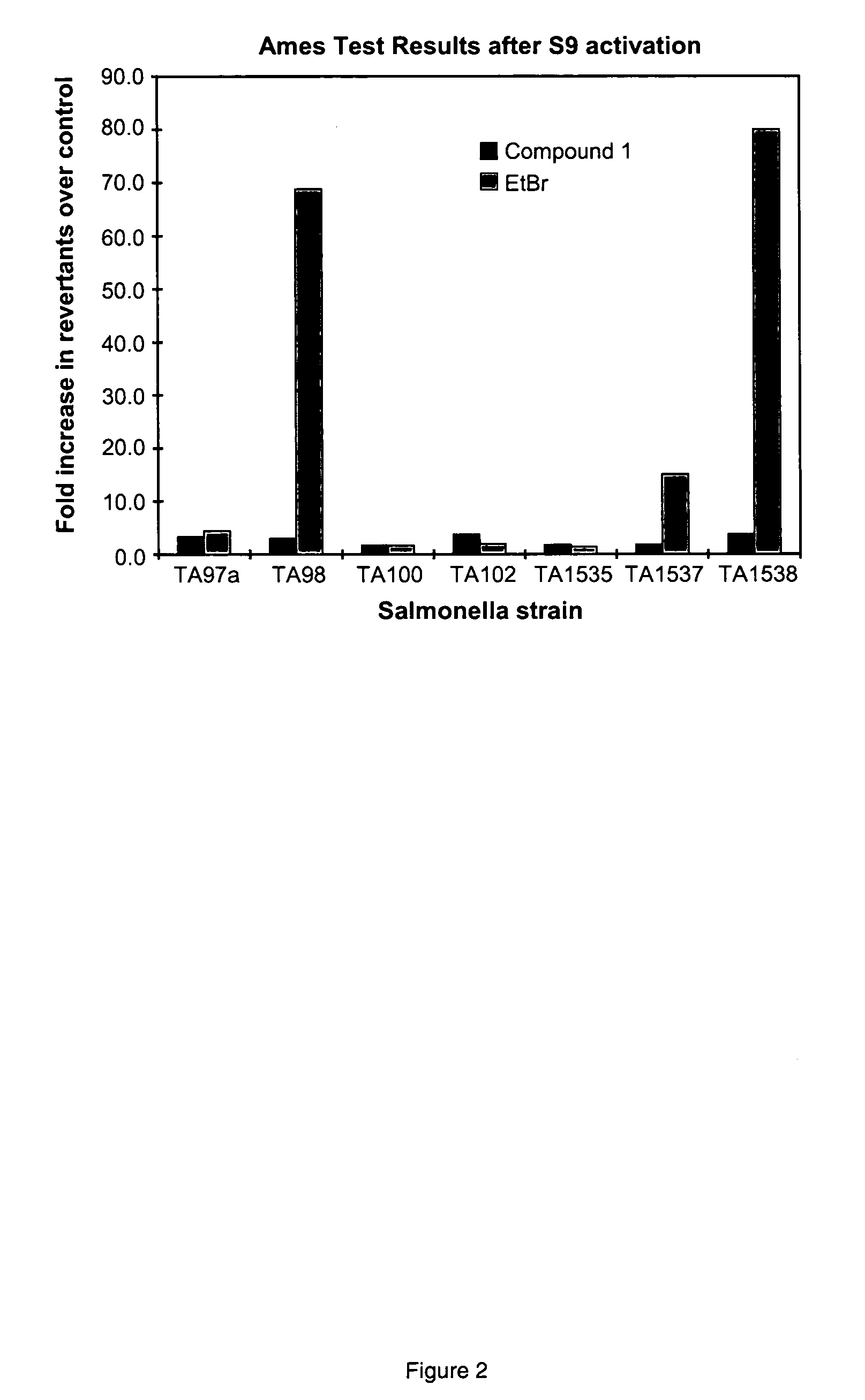Detection of immobilized nucleic acid
a nucleic acid and immobilization technology, applied in the field of cyanine monomer compounds, can solve the problem that pre-stained nucleic acid may also be immobilized
- Summary
- Abstract
- Description
- Claims
- Application Information
AI Technical Summary
Benefits of technology
Problems solved by technology
Method used
Image
Examples
example 1
Detection of DNA in an Agarose Gel with Thiazole Orange and Compound 1
[0119]Different concentrations of DNA (62.5 ng, 31.25 ng, 15.63 ng, 7.813 ng, 3.906 ng, 1.953 ng, 976.6 pg, 488.3 pg, 244.1 pg, 122.1 pg, 61.04 pg and 30.52 pg) were loaded and separated on a 1% agarose gel at 80v in 0.5×TBE. The gels were stained with a staining solution comprising TBE (50 mL) and either thiazole orange or compound 1 (4.54 μl of dye stock solution in DMSO). Alternatively, the gels were prepared to contain either thiazole orange or Compound 1 wherein 1 g of agarose, 100 ml of 0.5×TBE was mixed with either 9.08 μl of thiazole orange or Compound 1 stock solution. The DNA was loaded and separated in 0.5×TBE at 80v. Some of these gels were also post stained with staining solution. All gels were subsequently photographed. These gels demonstrate the ability of thiazole orange and a derivative thereof to detect nucleic acid separated and immobilized in a gel. See, FIG. 1.
example 2
Salmonella / Mammalian Microsomal Reverse Mutation Assay (Ames Test)
[0120]The Ames assay was performed using the method described by Ames (Ames et al Mutation Research 31 (1975) 347-364; Levin et al. PNAS 79 (1982) 7445-7449; Maron and Ames, Mutation Research 113 (1983) 173-215). Tester stains used were Salmonella typhimurium histidine auxotrophs TA97a, TA98, TA100, TA102, TA1535, TA1537 and TA1538. The assay was performed with test compounds (Ethidium bromide, thiazole orange and Compound 1) at six doses in both the presence and absence of S9 (rat liver extract), along with appropriate vehicle and positive controls (Singer et al. Mutation Research 439 (1999) 37-47). The test compounds, test vehicle and S9 (when appropriate) were combined with molten agar and then overlaid over a minimal agar plate. Following incubation at 37° C., revertant colonies were counted. When S9 was not used, 100 μl of tester strain and 50 μl of control or test compound were added to 2.5 ml of selective top a...
example 3
In Vitro Transformation of Syrian Hamster Embryo (SHE) Cells by 7-day Exposure Screening Assay
[0123]This assay design is based on procedures described by Kerchaert et al Mutation Research 356 (1996) 65-84, and is an accepted method for evaluating the carcinogenic potential of chemical substances. Thus, the objective of the assay was to determine the ability of the test compounds (Ethidium bromide, thiazole orange and Compound 1) for inducing an increase in morphological transformation of cultured Syrian hamster embryp cells, relative to vehicle control cultures, following a 7-day exposure period.
[0124]SHE cell cultures were grown in LeBoeuf's modification (0.75 g / L NaHCO3, pH 6.65-6.75) of Dulbecco's Modified Eagle Medium (DMEM) supplemented with 20% fetal bovine serum (FBS) and 4 mM L-glutamine. The cultures were maintained at 37±1° C. in an atmosphere of 10±0.5% CO2 in humidified air. The known procarcinogen, benzo[a]pyrene (B[a]P) was used as a positive control, dissolved in DMSO...
PUM
| Property | Measurement | Unit |
|---|---|---|
| light wavelength | aaaaa | aaaaa |
| light wavelength | aaaaa | aaaaa |
| light wavelength | aaaaa | aaaaa |
Abstract
Description
Claims
Application Information
 Login to View More
Login to View More - R&D
- Intellectual Property
- Life Sciences
- Materials
- Tech Scout
- Unparalleled Data Quality
- Higher Quality Content
- 60% Fewer Hallucinations
Browse by: Latest US Patents, China's latest patents, Technical Efficacy Thesaurus, Application Domain, Technology Topic, Popular Technical Reports.
© 2025 PatSnap. All rights reserved.Legal|Privacy policy|Modern Slavery Act Transparency Statement|Sitemap|About US| Contact US: help@patsnap.com



